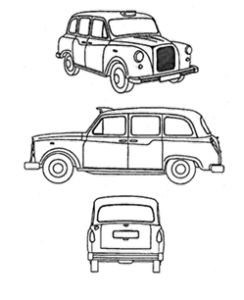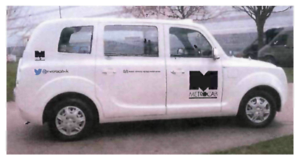A recent decision of the U.K Court of Appeal illustrates the difficulties in enforcing trademarks consisting of the shape of goods.
The Facts
The London Taxi Corporation Limited (“LTC”) is the registered owner of a Community Trade Mark registered in respect of “motor vehicles”, among other things. The mark is a three-dimensional trade mark as shown below:

LTC is also the registered owner of a similar U.K. three-dimensional trade mark.
Frazer-Nash Research Limited (”FNR”) is the successor in title to the manufacturers of several models of competing London taxi, called the Metrocab. After an extensive process of development and testing, FNR developed the hybrid electric Metrocab shown below:


When LTC learned of FNR’s plans it immediately brought an action for infringement of its trademarks and passing off.
The Trial
After a trial it was found that both of the LTC marks were invalid on several grounds. Further, even had the LTC marks been valid, it was found they would not be infringed by the new Metrocab. The claim based on the common law tort of passing off was also dismissed.
The Appeal
One of the issues on appeal was who was an average consumer for the purposes making the assessments relevant to the issues under appeal. The court said that as with all issues in trademark law, the answer to disputed questions is normally provided by considering the purpose of a trademark which, broadly speaking is to operate as a guarantee of origin to those who purchase or use the product. In principle, the term average consumer includes any class of consumer to whom the guarantee of origin is directed and who would be likely to rely on it, for example in buying or using the goods. This included users who took complete possession of the taxis and individuals who hired the taxis in issue.
A trademark registration is invalid if the mark is devoid of distinctive character. The required distinctiveness can be either inherent or acquired through use of the mark. To be inherently distinctive a mark consisting of the shape of a product must depart significantly from the norm or customs of the sector for products of that kind. In addition the mark must be perceived by the average consumer as identifying the origin of the goods.
The court agreed that the LTC marks lacked inherent distinctiveness. When the LTC features are compared with these basic design features of the car sector, whether considered individually or as a whole, the LTC features were simply minor variants of those norms and customs.
To show acquired distinctiveness LTC had to prove that, as a result of the use of its marks, a significant proportion of the relevant class of purchasers and users perceived the marks as identifying the taxis as originating from it and so to distinguish its taxis from those of other undertakings.
It is not sufficient for the trademark owner to show that a significant proportion of the relevant class of persons recognise and associate the mark with the trademark owner’s goods. It must be shown that they perceive that the goods designated by the mark originate with a particular undertaking and no other.
The trial judge concluded that the evidence was not adequate to establish that taxi hirers perceived the shape of the taxi as denoting vehicles associated with LTC and no other manufacturer. The Court of Appeal agreed.
Finally, the court agreed with the trial judge concerning the dismissal of the claim of passing off. LTC faced the same difficulties in establishing the goodwill for a passing off action as it did in relation to showing acquired distinctive character for its trade marks. In addition, the design of the new Metrocab was strikingly different to that of LTC’s taxis.
The Canadian Position
The law in Canada is similar but inherent distinctiveness is not directly relevant. Currently protection as a trade mark would be as a “distinguishing guise”. A “distinguishing guise” means a shaping of the goods the appearance of which is used by a person for the purpose of distinguishing goods manufactured, sold, leased, or hired by it from those manufactured, sold, leased, hired, or performed by others.
A distinguishing guise is registrable only if a) it has been so used in Canada by the applicant or its predecessor in title as to have become distinctive at the date of filing of an application for its registration; and b) the exclusive use by the applicant of the distinguishing guise in association with the wares or services with which it has been used is not likely unreasonably to limit the development of an art or an industry. No registration of a distinguishing guise interferes with the use of any utilitarian feature embodied in the distinguishing guise.
Unlike an ordinary application for a trademark, an applicant seeking to register a distinguishing guise must provide evidence to establish that the distinguishing guise has been used in Canada so as to have become distinctive. The onus of showing distinctiveness is on the applicant and has been categorized as a heavy burden similar to that required to show acquired distinctiveness or secondary meaning.
Conclusion
The result in this case is consistent with recent cases in both the U.K and Canada. There is marked reluctance to grant protection in these cases since the term of protection for a trademark registration is unlimited.
John McKeown
Goldman Sloan Nash & Haber LLP
480 University Avenue, Suite 1600
Toronto, Ontario M5G 1V2
Direct Line: (416) 597-3371
Fax: (416) 597-3370
Email: mckeown@gsnh.com
These comments are of a general nature and not intended to provide legal advice as individual situations will differ and should be discussed with a lawyer.
